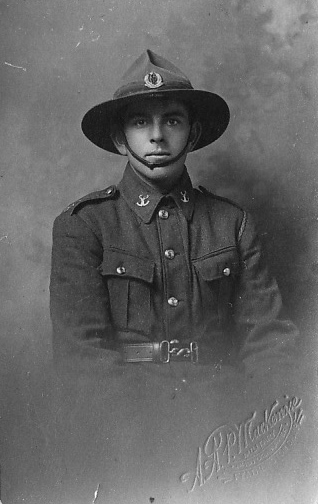Pte
Lewis Roy Gordon (Roy) Haycock
Informationen zu Geburt
|
Geburtsdatum: 19/03/1895 |
|
Geburtsort: Brightwater, Tasman, New Zealand |
Allgemeine Informationen
|
Beruf: Landwirt / Bauman / Ökonom |
Informationen zum Armeedienst
|
Land: New Zealand |
|
Truppe: New Zealand Expeditionary Force |
|
Rang: Private |
|
Dienstnummer: 11661 |
|
Einberufung datum: 11/01/1916 |
|
Einberufung ort: Trentham, Wellington, New Zealand |
|
Einheiten: — Canterbury Regiment, 2nd Bn. (Letzte bekannte Einheit) |
Informationen zu Tod
|
Sterbedatum: 12/10/1917 |
|
Sterbeort: Bellevue 's, Graventafel, Belgien |
|
Todesursache: Im Kampf gefallen |
|
Alter: 22 |
Gedenkstätte
|
Tyne Cot, New Zealand Apse Tafel: 3. A. |
Auszeichnungen und Orden 2
|
British War Medal Medaille — 20/10/1921 |
|
Victory Medal Medaille — 28/08/1922 |
Punkte von Interesse 3
| #1 | Geburtsort | ||
| #2 | Einberufung ort | ||
| #3 | Ort des Todes (ungefähr) |
Meine Geschichte
Private Lewis Roy Gordon Haycock was part of the 12th company of the 2nd Battalion Canterbury Regiment, 2nd New Zealand Brigade, New Zealand Division. His battalion took part in the First Battle of Passchendaele on 12 October 1917. The 2nd and 12th companies of the 2nd Battalion Canterbury Regiment went forward on the night of the 10th/11th with the 2nd Otago battalion and dug in near Korek and Boethoek on the Graventafel Spur. On the 12th of October the 2nd Otago Battalion attacked the first objective around Bellevue, but the advance was stopped by machine gun fire from German pillboxes located on at the Graventafel-Mosselmarkt road. The 2nd and 12th companies of the 2nd Canterbury Battalion were called up from reserve and tried to flank the pillboxes in Bellevue, but failed due to the heavy fire from the German pillboxes and the lines of barbed wire. After both attacks had failed the advance crumbled and men still in the field came under machine gun and sniper fire. Private Lewis Roy Gordon Haycock was reported missing after the attack and later reported killed in action. His notebook (dated 1917) did find its way back to his relatives in New Zealand despite the fact that he was missing. How this happened remains a mystery, but it's not unlikely that he gave the notebook to a friend or chaplain before the battle (his last entry was made on the 10th) to safeguard it in case something happened to him. This person could have returned it to New Zealand.
Quellen 4
|
Ferguson David, The History of the Canterbury Regiment N.Z.E.F. 1914-1919, (Uckfield, the Naval & Military Press Ltd, 1921), p 196-198. Verwendete Quellen |
|
Latter Edward, Marching Onward: the history of the 2nd Battalion Royal New Zealand Infantry Regiment, (Christchurch, Regimental Published,1992), p 72. Verwendete Quellen |
|
McCarthy Chris, Passchendaele : The Day-by-Day account, (London, Uniform, 2018), p 128-131. Verwendete Quellen |
|
Palmer Richard, The life and death of a New Zealand soldier in World War One, (London, Copy Press, 2015), p 139 -143. Verwendete Quellen |
Weitere Informationen 5
|
Commonwealth War Graves Commission Database https://www.cwgc.org/find-records/find-war-dead/casualty-details/847649 |
|
Namenlijst (In Flanders Fields Museum) https://namenlijst.org/publicsearch/#/person/_id=4bbd9b62-eee9-4fc2-b202-0915125954cf |
|
Lives of the First World War (Imperial War Museum) https://livesofthefirstworldwar.iwm.org.uk/lifestory/7176137 |
|
The NZEF Project (UNSW Canberra) https://nzef.adfa.edu.au/showPerson?pid=110904 |
|
Online Cenotaph (Auckland Museum) https://www.aucklandmuseum.com/war-memorial/online-cenotaph/record/c6635 |
